Catholic funerals follow specific rituals
Friday, Oct. 30, 2015

Intermountain Catholic
+ Enlarge
Caskets for Catholics are draped with white palls to as a reminder of the promises of the Sacrament of Baptism.
SALT LAKE CITY — During the grief-filled preparation for a loved one’s funeral, “the most important thing for Catholics to know is the beautiful gift of the Mass that we are offering for the deceased loved one,” said Father Andrew Skrzpiec, pastor of Saint Ambrose Catholic Church. The funeral Mass is a special gift reflecting “the salvation of Christ’s offering at that moment to that person and to all of us supporting them with love and presence and prayer.”
The Scripture readings and music for a funeral Mass should reflect the service’s prayerful character, Fr. Skrzpiec said; eulogies should be given at the vigil, although the priest’s or deacon’s homily may incorporate information about the deceased.
Many Catholics aren’t aware that, although the Catholic Church allows cremation, the rite calls for the body to be present at the funeral Mass, Fr. Skrzpiec said. Also, the Church requires the ashes to be committed to a final hallowed resting place, not scattered or placed on a mantelpiece.
Another common misconception is that the Sacrament of Anointing of the Sick should be reserved until a person’s last moments on earth. In truth, “the Sacrament of Anointing is for the living,” Fr. Skrzpiec said, adding that preferably this rite is celebrated while the person can actively participate.
According to the U.S. Conference of Catholic Bishops, “The Rite of Anointing tells us there is no need to wait until a person is at the point of death to receive the Sacrament. A careful judgment about the serious nature of the illness is sufficient. … For those who are about to depart from this life, the Church offers the person Penance, Anointing of the Sick, and the Eucharist as Viaticum (food for the journey) given at the end of life.”
When a family is arranging for a Catholic funeral, mortuary personnel can offer suggestions about services that follow the proper rites but still are personalized, said Travis Greenwood, manager of Larkin Mortuary in Salt Lake City.
Options include holding the services at the mortuary, in a church or at the graveside, Greenwood said, adding that, when making arrangements, he is in constant communication with the priest or deacon who will be celebrating the rites, which can include a rosary at the vigil at the family’s request.
“We want to follow the family’s wishes, but sometimes they don’t know what they want,” or they are unaware of the legal aspects involved with funerals, Greenwood said.
For example, in Utah, if a person wishes to be cremated after death, that desire must be clearly stated in a legal document. Otherwise, the deceased’s spouse can make the arrangements; if the next of kin are children, a majority of them must agree to the cremation unless the power of attorney clearly outlines the disposition of the remains, Greenwood said.
In addition to making decisions about the services, families will be asked to choose flowers, to compose an obituary, and settle many other such details; all of this is usually required within a few days of the loved one’s death.
Making such decisions quickly is daunting, Greenwood said, which is one reason he suggests that people make arrangements for their own funerals.
“When you’re arranging your funeral, you’re able to clearly discuss and think about what you want to have done,” he said. “The benefits of doing that prior are a huge blessing. When families come in and they have those arrangements already done, it does take a big weight off of their shoulders” because they know their loved one’s wishes.
For example, “I hear families say all the time, ‘Gosh, what would Mom or Dad want? Would they want a metal casket, or would they want a wood casket?’” Greenwood said.
When working with the cemetery, families should be prepared to show ownership of the grave if it has been pre-purchased, said John Curtice, director of Mount Calvary Catholic Cemetery. He prefers 24-hour notice of a burial, and if the family is purchasing a grave, he asks family members to visit the cemetery so that they can view the site.
At the funeral service, the priest or deacon should consecrate the deceased’s grave, because “it’s their final resting place,” even in a Catholic cemetery, which is already hallowed ground, Curtice said.
Families should also inform cemetery officials about any special graveside services, such as a military burial, Curtice said, adding that he prefers the family to disperse after the services because of the safety concerns of having people near the heavy equipment required for the burial. If the family chooses to remain for the burial, he asks that prior arrangements be made.
If the deceased has been cremated, the urn should be encased in a vault, which prevents the ashes from being disturbed, Curtice said.
For grave markers, Curtice suggested taking time to decide the final details. At Mt. Calvary, headstones aren’t set in the winter because of the weather, which also prevents graves from being sodded except in the spring and fall, he said.
For questions, comments or to report inaccuracies on the website, please CLICK HERE.
© Copyright 2024 The Diocese of Salt Lake City. All rights reserved.
© Copyright 2024 The Diocese of Salt Lake City. All rights reserved.

Stay Connected With Us